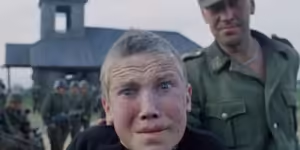Why Did Elem Klimov Never Make Another Movie?
Why Did Elem Klimov Never Make Another Movie?

There are plenty of reasons why Soviet filmmaker Elem Klimov’s 1985 anti-war film Come and See is considered by many as one of the greatest (and most gut-wrenchingly brutal) visual works of all time, one of which is that the film’s ‘climax’ is a 25-minute sequence featuring one of the most disturbing depictions of wartime Hell ever shot. The film, written by Klimov and Belarussian writer Ales Adamovich, is centered on the latter’s 1971 novella Khatyn (about the titular Khatyn village massacre during WWII) and his 1977 memoir Out of the Fire, which was founded on the true-life testimonies of over 300 Belarussian survivors of Nazi atrocities.
The fact that it is so closely based on true stories makes it additionally frightening to watch, but films aren’t typically produced for the sole goal of escapism. While cinema can transport viewers to faraway universes or historical eras, it can also bring viewers as close to tragedy as humanly possible, providing an experience that informs and enforces emotional compassion in a time that audiences would rather ignore.
What Exactly Is Elem Klimov’s ‘Come and See’ About?

For Elem Klimov, amnesia was never an option, as the director of the production process to guarantee the piece’s authenticity throughout. Set in 1943, Come and See follows Flyora (Aleksei Kravchenko in an incomparable depiction of wartime youth), a 14-year-old Belarussian boy delighted to find a fallen soldier’s rifle buried amid a sand-filled trench.
He runs home to his mother (Tatyana Shestakova), announcing that he wants to join the Soviet partisan army, and in a scene that starts barely five minutes into the film, his mother reproaches him about the awful realities of warfare for which he is undoubtedly unprepared, imploring him to kill her and the rest of his siblings as if he is leaving them for death, and they should all “get it over with”.
Come and See’s climax Is A Chaotic, Uncompromising Look At The Terrible Consequences Of War

In war movies, it’s usual for innocent soldiers to witness the horrible horrors of war after discovering an engulfed city or town up close. Soldiers killing each other is one thing, but soldiers killing innocents can be particularly repugnant since it exposes characters to the faults of not just an army, but the entire race as a whole. Some of the more severe war films (for example, The War Game or Barefoot Gen, which extend the same idea to nuclear war) depict not merely the aftermath but also the destruction as it unfolds.
While some may see this approach as cruel, portraying a tragic story that does not necessarily belong to the filmmakers telling it, a true anti-war film can only strive for authenticity, lest the human race’s unsuccessful attempts be sugar-coated and trivialized with time.
So Why Did Elem Klimov Never Make Another Movie?

It’s beyond the long takes or technical ability that makes those 25 minutes so valuable. In a discussion from the 1986 Denver International Film Festival, Elem Klimov stated that he desired to create something more akin to a documentary, as to achieve the team’s targets, “we had to be realistic to the maximum.” Klimov was in favor of shooting the movie in black-and-white, as many war films and documentaries of the era had done in an attempt to retain that sense of real life, even if the film’s colors are drab and muted as if looking at the world through glasses smoldered in the ash clouds of bombs.
Furthermore, Klimov shot the film entirely on Belarussian soil and insisted on recruiting non-professional actors to dismantle the notion of professionalism and make the creators “disappear”. He goes on to explain, “I mean that we shouldn’t be thinking about becoming executives, photographers, actors, or film professionals.” “All of this had to dissolve into the action itself.” Klimov did not want the film to be recognized as a technical achievement. Instead, he sought to demonstrate the war as a memory. It is not a Hollywood or even a Soviet extravaganza, but rather 2 hours and 22 minutes of sheer trauma pumping into the audience’s minds.
Elem Klimov Last Movie Ever…..

It is hardly surprising that Elem Klimov stopped producing films after Come and See, submitting that he “lost interest” because “everything possible [he] felt [he] had already done.” What makes the production process even more painful is Klimov’s wife, Larisa Shepitko (herself a critically acclaimed filmmaker whose best-known movie, The Ascent, obtained the Golden Bear at the 27th Berlin International Film Festival), tragically passed away in an automobile accident in 1979.
When filming on the project finally began, Klimov must have funneled his constant anguish into his work, because Come and See is undoubtedly developed by creators reliving their lowest moments for a great work of sincere anti-war cinema. Come and See lacks the camaraderie in films like Saving Private Ryan or the joyful relief seen at the end of 1917. Instead, this film is true war, with its raw, ruthless, and ignorant agony.

